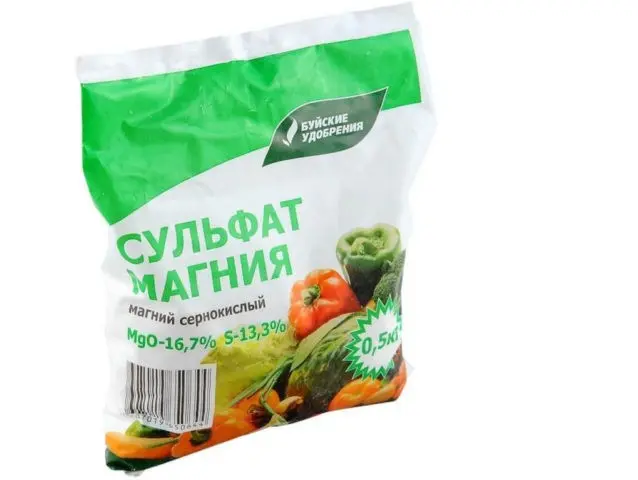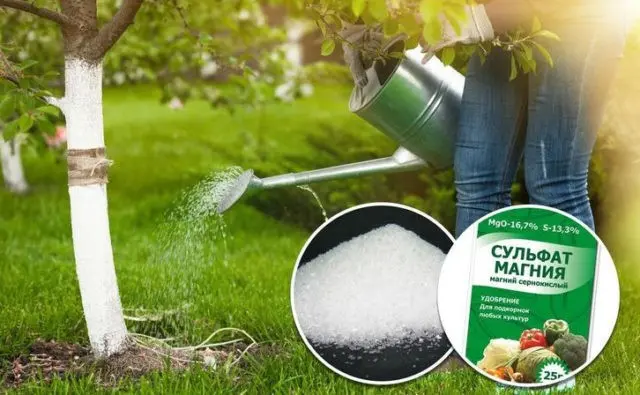Contents
- What role do magnesium and sulfur play in plant development?
- Signs of micronutrient deficiencies in plants
- Composition and properties of magnesium sulfate fertilizer
- How to use magnesium sulfate for plants in the garden
- The use of magnesium sulfate for fruit crops
- How to Use Magnesium Sulfate for Houseplants
- How to use magnesium sulfate for feeding conifers and ornamental plants
- Application of magnesium sulfate fertilizer for flowers
- Instructions for use magnesium sulfate for indoor flowers
- Advice of professionals
- Conclusion
Few gardeners are aware of the benefits of magnesium sulfate fertilizer for plants. The substances contained in its composition have a positive effect on the growth and development of vegetable crops. Top dressing will also be useful for indoor flowers, as macronutrients restore the plant’s immunity, improve its appearance and increase the duration of flowering. Epsom salts are also used for preventive purposes.

Magnesium sulfate is available as a white crystallized powder.
What role do magnesium and sulfur play in plant development?
In the garden, magnesium sulfate is vital. It improves the taste of vegetables and fruits, increases yield. Supports immunity, which is very important for young seedlings, reduces the adaptation process after planting in a new place.
It is more expedient to add magnesia to the soil together with mineral complexes, then the plant will better absorb nutrients in the form of nitrogen, potassium and phosphorus.
Mg is especially useful for garden plantings such as tomatoes, potatoes and cucumbers, as the element increases the production of starch and sugar. For all other crops, it helps to better absorb the nutrients that they need for life, namely:
- fats;
- essential oils;
- calcium;
- ascorbic acid;
- phosphorus.
In addition, magnesium has an anti-stress effect. It protects the leaves from direct sunlight, prevents the root system from freezing, and the fruits from spoiling.
Any vegetation with a lack of magnesia becomes extremely sensitive to external environmental influences.
Signs of micronutrient deficiencies in plants
In fact, magnesium sulfate is extremely important for all garden plantings: vegetables, flowering shrubs and fruit trees. But top dressing is recommended only when the plant is deficient in magnesium and sulfur.
You can tell that this moment has come by the following signs:
- The appearance of interveinal chlorosis on the foliage, when a characteristic marble pattern is drawn on them.
- A change in the color of the leaf plate, it becomes brown in color and begins to dry and curl.
- Active leaf shedding indicates a critical lack of magnesium.
- On fruit trees and shrubs, fruits do not ripen or shrink, in which case the plants lack potassium.
- Slow growth and development is a clear sign of poor absorption of sulfur, discoloration of the foliage also indicates that the plant is deficient in this element.

Interveinal chlorosis is the first sign of magnesium deficiency.
With insufficient sulfur content in the soil, the activity of soil bacteria is reduced. It depends on their vital activity and activity how much nutrients the plant will receive. Actually, therefore, it is important to monitor the level of sulfur, the indicator should vary in the range of 10-15 kg per 1 ha. That is how much it takes for garden plantings to fully grow, develop and bear fruit well.
The use of magnesium sulfate for plants must be approached carefully. Incorrect dosage can adversely affect plantings. Sulfur with insufficient oxygen is converted into hydrogen sulfide, and it, in turn, is detrimental to the root system of the plant.
Composition and properties of magnesium sulfate fertilizer
Magnesium sulphate is a valuable source of Mg and sulfur ions, these elements are necessary for all types of plantings in the garden and indoor flowers. Fertilizing plants with magnesium sulfate provides better absorption of many nutrients, including potassium and phosphorus. And they are responsible for the development of the root system.
The composition contains:
- sulfur (13%);
- magnesium (17%).
Depending on the manufacturer, these figures may vary slightly. It is a white or light gray crystalline powder. It dissolves well in water at room temperature.
The low hygroscopicity of the composition allows you to store the powder on the street, but it should be protected from direct sun and precipitation.
Magnesia acts as a “first aid” for horticultural crops that are deficient in magnesium. In addition, the substance helps to regulate the content of proteins in fruit bushes and fruit trees, as well as in their fruits.
How to use magnesium sulfate for plants in the garden
Vegetables need magnesium supplementation during the growing season. The solution is prepared strictly according to the instructions, each culture has its own dosage:
- tomatoes and cucumbers – 30 g per 10 liters of water;
- carrots and cabbage – 35 g per 10 liters of water;
- potatoes – 40 g per 10 liters of water.
After that, the liquid is poured under the root of the plant, and the perimeter of the near-stem circle is also treated. To stimulate growth, water the soil with a magnesium solution every two weeks.
The use of magnesium sulfate for fruit crops
Magnesia helps fruit trees and berries to better endure the winter period, making them more frost-resistant and resistant to temperature fluctuations.
Foliar fertilizing with magnesium sulfate is carried out in the fall. Operate according to the following instructions:
- Mix warm water (10 l) and powder (15 g).
- Everything is thoroughly mixed.
- They bring 5 liters under one shrub, 10 liters under an adult tree.

Before adding magnesia, it is necessary to deoxidize the soil, this is done by liming
In spring, fertilizers are applied directly to the soil. They do this to increase the yield and quality of the fruit. The powder is laid in specially made grooves, then sprinkled with earth and watered abundantly.
How to Use Magnesium Sulfate for Houseplants
At home, magnesia is used to improve the process of photosynthesis. Most often, the apartment has insufficient lighting for the normal development of a flower, and the less light it receives, the more it consumes macronutrients.
This type of top dressing has a unique feature – it does not pollute the substrate, unlike many of its counterparts. That is, the remains simply remain in the ground until the flower again experiences a shortage in it.
It is necessary to dilute pharmacy magnesium sulfate for plants strictly according to the instructions. But for flowers, the concentration should be greater than for vegetables.
How to use magnesium sulfate for feeding conifers and ornamental plants
For conifers and ornamental trees, magnesium supplements are needed. The fact is that they obtain chlorophyll, which is vital for them, through photosynthesis. And this process directly depends on magnesium. Fertilizer with magnesia promotes the emergence of new apical branches and the growth of green mass.
Top dressing is carried out in early May. To do this, the root zone is mulched with powder, hay or fallen needles, then even the most severe frosts will not be afraid of the root system. You can also prepare a solution of magnesium sulfate in ampoules, any option is suitable for plants.
Application of magnesium sulfate fertilizer for flowers
Epsom salt is used as a fertilizer for flowering crops, so it is actively used in indoor floriculture.

Spraying with a magnesium sulfate solution improves the appearance of houseplants
Regular top dressing increases the resistance of flowers to diseases, to the attack of pests, and increases resistance to harmful environmental influences.
In addition, fertilizing with magnesium sulfate has a positive effect on the quality of flowering and its duration.
Instructions for use magnesium sulfate for indoor flowers
As a rule, detailed recommendations on how to prepare and use a solution for plants are in the instructions for use of magnesium sulfate. Loose powder can be taken in its pure form – it can be applied directly to the soil. You can dilute, and then spray the bushes with a ready-made solution or carry out foliar top dressing. To do this, take 10 g of powder per 5 liters of warm water. The soil is watered once a month, a flowering culture during flowering, the procedure is carried out more often – once every two weeks.
Advice of professionals
Magnesium sulfate can be applied together with other agrochemicals. Agronomists recommend applying fertilizer while preparing the soil for planting seeds.
In autumn, it is best to add magnesia to the soil in its pure form, and then dig it up with mineral complexes. During the winter, the salts will dissolve and the substrate will take on a form in which the root system of young seedlings takes root and adapts much faster.
Due to the fact that the drug does not inhibit vegetation, it can be added together with pesticides.

Magnesium sulfate has a positive effect on yield and fruit quality
Conclusion
The benefits of magnesium sulfate for plants are invaluable, fertilizers affect growth, appearance and fruiting. It can be used in any soil, but it is especially recommended to apply the powder to acidic areas where an increased concentration of nutrients is needed.









